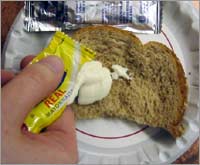|
Holy chicken salad! Healthy mayo
Tasty traditional mayonnaise has taken a licking as Americans become more health-conscious. Spanish scientists may have discovered a way for it to shine again
It's no surprise that mayonnaise, that creamy, tasty staple of the American fridge, is well beyond its salad days. Loaded with calories, fat, and cholesterol, mayo finds itself increasingly shunned, as Americans become more health conscious. Retail sales of mayo (at stores excluding Wal-Mart) have declined for the past two years, according to data tracker IRI. And just 41% of households polled last year had used mayonnaise at least once over the past two weeks, down from 45% in 1990, according to market researcher NPD Foodworld. Sandwich counters across the nation have had to jazz up mayonnaise with trendy flavors like chipotle in order to keep pace with its spicier cousin condiment, mustard.
Still, mayonnaise is found in three out of four kitchens - only ketchup is more ubiquitous - and good luck making your grandmother's famous potato salad without it. Perhaps mayo just needs a little innovation to regain its lost luster. Help may have arrived, thanks to Spanish researchers. They've found a way to make mayonnaise without using eggs. The process could not only cut costs but also produce a healthier product. Mayonnaise is made by slowly adding oil to a mixture of eggs, mustard, vinegar or lemon juice, and other seasonings. Eggs are the critical ingredient, as a substance called lecithin in the egg yolk acts as a fat emulsifier, melding the liquids together into a thick, tasty sauce. Emulsification experts from the universities of Huelva, Seville, and from other Spanish research outfits discovered that buttermilk, which is high in protein, has emulsifying properties that could impart a product similar to mayonnaise. (Buttermilk is produced when milk is skimmed.) The scientists analyzed the viscosity, elasticity, and texture of the emulsion, and tinkered with the formula to find the appropriate levels of buttermilk, water, and oil. Then, a group of expert tasters compared the creation to well-known mayonnaise brands on the market today. The team is now looking to patent this mayo alternative. If the product ever hits store shelves in the U.S., it would need a new name, as Food and Drug Administration guidelines prevent it from being called mayonnaise, according to spokesman Mike Herndon. (Kraft's Miracle Whip tastes like mayonnaise but is technically a salad dressing, for example.) And good luck convincing food manufacturers to offer this new mayo. Making mayonnaise from buttermilk is "not that difficult," according to Professor Mian Riaz, a food scientist at Texas A&M. The hard part is getting food companies to commit the money and manpower to make the switch, he says. C.F. Sauer of Richmond, Va., maker of Duke's mayonnaise, a popular brand in the South, produces an egg-free mayonnaise-like product for a client that, in turn, supplies the U.S. military. But "you wouldn't feed it to your house pets," says executive vice president of sales Mark Sauer. Still, Sauer acknowledges that the mayo market could use a boost. Duke's sales were flat last year. "Americans are not eating more mayo these days," he says, wistfully. "All those ladies whose mothers gave them a recipe for chicken salad - if it called for a cup of mayonnaise back then, they cut it in half. They just don't use as much as they used to." -------------------------------------------- Heinz CEO says firm is ketching-up. Click here.
Fat sells. Read more. |
|

